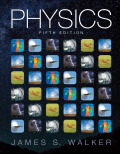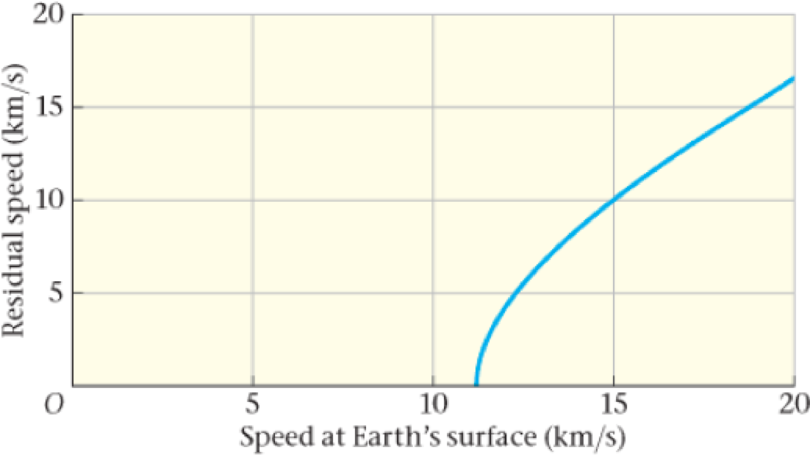
Concept explainers
If life exists elsewhere in our solar system, it may not have developed independently from life on Earth. Instead, it’s possible that microbes from Earth may have colonized other planets or moons by hitching a ride on a rock blasted from Earth’s surface by a meteor impact. If the impact gives the rock enough energy to escape into space (while at the same time not raising its temperature so high as to “cook” the microbes), the rock may eventually reach another body in the solar system. In fact, rocks from Mars are known to have reached Earth in just this way, although none are currently known to have contained microbes. Computer modeling can be used to estimate the probability that a rock ejected from the surface of the Earth with a speed greater than the escape speed will reach another planet. These computer models indicate that under the influence of gravitational fields from the other objects in the solar system, an ejected rock can take millions of years to travel from one planet to another. During this time any life “aboard” is continually exposed to the high
The accompanying plot shows the residual speed of an ejected object—that is, the speed the object would have when infinitely far from the Earth—as a function of its speed at the surface of the Earth (its original ejection speed). By simulating the motion of rocks ejected from the Earth with a variety of speeds, researchers conclude that 0.03% of the rocks ejected such that they have a residual speed of 2.5 km/s will have reached Mars 2.0 million years later. Although this doesn’t seem like a high probability, there have been so many meteor impacts over the long history of the Earth that many ejected rocks must have reached Mars—though whether they carried microbes, and if they did, whether the microbes would have survived, are open questions.

92. • What is the speed a rock needs to be given at the surface of the Earth in order for it to have a residual speed of 2.5 km/s?
- A. 8.7 km/s
- B. 10.9 km/s
- C. 11.5 km/s
- D. 13.7 km/s
Want to see the full answer?
Check out a sample textbook solution
Chapter 12 Solutions
Physics (5th Edition)
Additional Science Textbook Solutions
Introductory Chemistry (6th Edition)
College Physics: A Strategic Approach (3rd Edition)
Microbiology: An Introduction
Microbiology: An Introduction
Anatomy & Physiology (6th Edition)
Microbiology with Diseases by Body System (5th Edition)
- 3. By using the fact that around any closed loop the sum of the EMFS = the sum of the PDs. Write equations for the two loops shown in the cct below. 40 ΔΩ I₂ 4V (loop1 20 (loop2) 2v I+12 Use these equations to show that the current flowing through the 20 resistor is 0.75Aarrow_forward5. A potential divider circuit is made by stretching a 1 m long wire with a resistance of 0.1 per cm from A to B as shown. 8V A 100cm B sliding contact 5Ω A varying PD is achieved across the 5 Q resistor by moving the slider along the resistance wire. Calculate the distance from A when the PD across the 5 Q resistor is 6 V.arrow_forward4. A voltmeter with resistance 10 kQ is used to measure the pd across the 1 kQ resistor in the circuit below. 6V 5ΚΩ 1ΚΩ V Calculate the percentage difference between the value with and without the voltmeter.arrow_forward
- 1. A 9V battery with internal resistance 5 2 is connected to a 100 2 resistor. Calculate: a. the Power dissipated in the 100 2 resistor b. The heat generated per second inside the battery. C. The rate of converting chemical to electrical energy by the battery. 2. A 230 V kettle is rated at 1800 W. Calculate the resistance of the heating element.arrow_forward2. If each of the resistors in the circuit below has resistance R show that the total resistance between A and B is 5R/11 A Barrow_forward1. At 0°C a steel cable is 1km long and 1cm diameter when it is heated it expands and its resistivity increases. Calculate the change in resistance of the cable as it is heated from 0-20°C The temperature coefficient of resistance a, gives the fractional increase in resistance per °C. So increase in resistance AR = Ra.AT Where R, is the resistance at 0°C For steel a, 0.003 °C The coefficient of linear expansion a- gives the fractional increase in length per °C temperature rise. So increase in Length AL La-AT Where L, is the length at 0°C For steel a₁ = 12 x 10 °C-1 The resistivity of steel at 0°C = 1.2 x 10 Qmarrow_forward
- 1. F E 6V 10 1.1. B a 6V b C C Apply Kirchoff's 1st law to point C for the circuit above Apply Kirchoff's 2nd Law to loops: a. ABCFA b. ABDEA C. FCDEF d. Find values for currents a,b and c Darrow_forward2. The results of the Rutherford experiment can be categorized in 3 statements. Fill in the missing words Most 11. Some III. A few State which result gives evidence that the nucleus is a. heavier than an alpha particle b. very small compared to the size of the atom c. positively charged 3. Using values in the diagram derive an expression for r .0 e marrow_forward3. A 100 W light bulb is connected to 230 V mains supply by a cable with resistance 0.12. Determine the heat loss per second by the cable.arrow_forward
- 1. The image shows electrons flowing in a conductor with cross sectional area 1mm². A electron flow • Add an arrow showing the direction of current. B • Which end has the highest potential? • Calculate the current when 1019 electrons flow through the wire in 10 s. If there are 1026 electrons per unit volume what is the drift velocity of the electrons?arrow_forwardpls helparrow_forwardpls helparrow_forward
 AstronomyPhysicsISBN:9781938168284Author:Andrew Fraknoi; David Morrison; Sidney C. WolffPublisher:OpenStax
AstronomyPhysicsISBN:9781938168284Author:Andrew Fraknoi; David Morrison; Sidney C. WolffPublisher:OpenStax Foundations of Astronomy (MindTap Course List)PhysicsISBN:9781337399920Author:Michael A. Seeds, Dana BackmanPublisher:Cengage Learning
Foundations of Astronomy (MindTap Course List)PhysicsISBN:9781337399920Author:Michael A. Seeds, Dana BackmanPublisher:Cengage Learning Stars and Galaxies (MindTap Course List)PhysicsISBN:9781337399944Author:Michael A. SeedsPublisher:Cengage Learning
Stars and Galaxies (MindTap Course List)PhysicsISBN:9781337399944Author:Michael A. SeedsPublisher:Cengage Learning

 Stars and GalaxiesPhysicsISBN:9781305120785Author:Michael A. Seeds, Dana BackmanPublisher:Cengage Learning
Stars and GalaxiesPhysicsISBN:9781305120785Author:Michael A. Seeds, Dana BackmanPublisher:Cengage Learning





